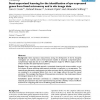Free Online Productivity Tools
i2Speak
i2Symbol
i2OCR
iTex2Img
iWeb2Print
iWeb2Shot
i2Type
iPdf2Split
iPdf2Merge
i2Bopomofo
i2Arabic
i2Style
i2Image
i2PDF
iLatex2Rtf
Sci2ools
BMCBI
2007
2007
Semi-supervised learning for the identification of syn-expressed genes from fused microarray and in situ image data
Background: Gene expression measurements during the development of the fly Drosophila melanogaster are routinely used to find functional modules of temporally co-expressed genes. Complimentary large data sets of in situ RNA hybridization images for different stages of the fly embryo elucidate the spatial expression patterns. Results: Using a semi-supervised approach, constrained clustering with mixture models, we can find clusters of genes exhibiting spatio-temporal similarities in expression, or syn-expression. The temporal gene expression measurements are taken as primary data for which pairwise constraints are computed in an automated fashion from raw in situ images without the need for manual annotation. We investigate the influence of these pairwise constraints in the clustering and discuss the biological relevance of our results. Conclusion: Spatial information contributes to a detailed, biological meaningful analysis of temporal gene expression data. Semi-supervised learning pr...
| Added | 12 Dec 2010 |
| Updated | 12 Dec 2010 |
| Type | Journal |
| Year | 2007 |
| Where | BMCBI |
| Authors | Ivan G. Costa, Roland Krause, Lennart Opitz, Alexander Schliep |
Comments (0)

